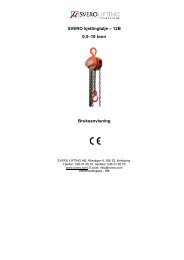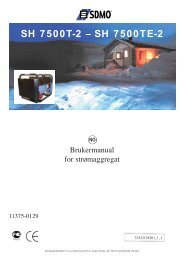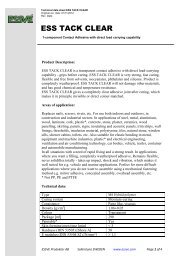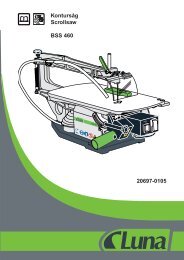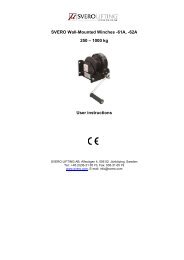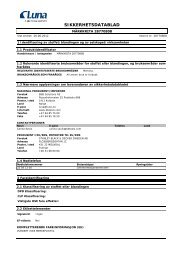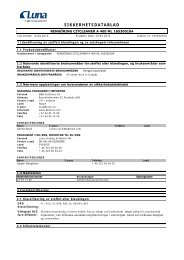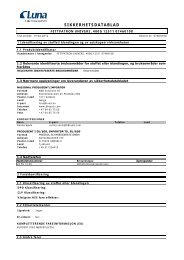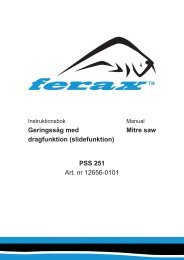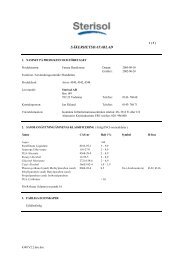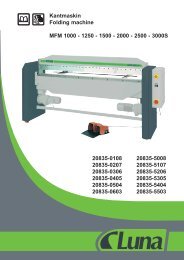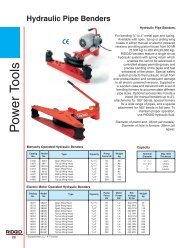Instruction manual 12894
Instruction manual 12894
Instruction manual 12894
You also want an ePaper? Increase the reach of your titles
YUMPU automatically turns print PDFs into web optimized ePapers that Google loves.
plug. Three wires are provided for the supply (L1, L2, L3) and<br />
the fourth (yellow/green) must be connected to the earth terminal.<br />
IMPORTANT: Three phase connection necessaries checking the<br />
correct direction of rotation of the motor shaft to avoid any problems<br />
with the belt drives.<br />
It is essential t start the motor for the first time without a drive<br />
belt. If necessary, reverse the position of 2 of the 3 supply wires<br />
from the mains to obtain the correct rotation for the normal<br />
cutting direction.<br />
In the event of a change to the 3 phase supply (variety of supply<br />
points, more than one socket in a basement, etc.), it is essential t<br />
repeat this check on the direction of rotation as explained above.<br />
NOTE: For a temperature below 10°C we recommend warning up<br />
the motor by letting it run off-load on any function.<br />
WARNING: Before adjusting or exchanging knives and any<br />
maintenance or repairs disconnect the machine from the mains.<br />
If the operator is standing at the side of the machine against the<br />
backstop, the main cutterblock has to be rotated clockwise (consequently<br />
to the right). It is possible to change the rotation direction<br />
by exchanging (switch-over) wires (black and/or brown) for<br />
three-phase motors.<br />
ATTENTION: The machine is injury menaces with the contrary<br />
rotation of the cutter block. Switch on the machine only for a while<br />
to find out the right direction of rotating (if possible – without<br />
tool).<br />
The machine is also equipped with brake motor, which is able to<br />
stop the machine within required time. However, this brake motor<br />
works only when the machine is switched off by pushing red button<br />
or emergency stop cover.<br />
When the brake does not work properly, it is forbidden to work<br />
with the machine.<br />
The switch cannot be turned on until the machine is connected to<br />
the mains. The switch is turned off automatically by way of neutral<br />
protection with outage, it means that it is necessary to switch on<br />
the machine again after restoring of the current. Should the machine<br />
is switched off frequently in sequence (twice of threefold),<br />
check up the machine (the motor functions, the blunt tool, etc.).<br />
The machine can be secured with a padlock placed on the switch<br />
which protects the machine from unauthorized usage.<br />
NOTE: If the protection system is not repositioned completely,<br />
feedback circuit will restrict the motor starting.<br />
GENERAL INFORMATION<br />
This combination-designed machine allows the operator to perform<br />
the following operations consecutively: surface planing,<br />
thicknessing.<br />
Surface planing: Adjustable infeed table, max. cut depth 5mm.<br />
Thicknessing: Table height adjustable by hand wheel and button<br />
position locking – Chip discharge case for correct chip discharge –<br />
Pass limiter – Extraction nozzle – Anti-throw-out pawl.<br />
TECHNICAL DATA<br />
Machine dimension FHM-260 FHM 310-E<br />
Length .................................................................. mm 1085 1350 1<br />
Width ....................................................................mm 485 600 1<br />
Height ...................................................................mm 820 1200 1<br />
Planer tables ........................................................ mm 1050 x 250 1285 x 310<br />
Thicknesser tables ...............................................mm 600 x 250 600 x 310.<br />
Cutterblock diameter ........................................... mm 75 75 1<br />
Number of knives ................................................pcs 3 3 1<br />
Cutterblock speed ................................................rpm 4000 4000 1<br />
Max removal thickness .......................mm(Planing) / 5 5 1<br />
.......................................................mm(Thicknessing) 2.5 2.5 1<br />
Max workpiece width ..........................................mm 250 310 1<br />
Net weight ............................................................ kgs 150 179 1<br />
NOISE LEVELS<br />
The manufacturer must inform the user concerning:<br />
- the equivalent continuous sound level (Laeq), if the latter<br />
exceeds 70 dB(A) at the work station,<br />
- the sound power level (LWA), if the Laeq exceeds 85dB(A) at<br />
the work station,<br />
- the peak pressure level (Lpc), if it exceeds 135 dB(A) at the station,<br />
- the measuring methods used.<br />
REFERENCE STANDARDS: ISO 7960<br />
- Operating conditions for noise measurements<br />
Annex B one-face surface planers<br />
Annex C one-face thicknessers<br />
- NF S31-084 – methods for measuring sound levels in a working<br />
environment for purpose of evaluating workers’ daily level of<br />
sound exposure,<br />
- NF S31-069 – test procedure for measuring noise emitted by<br />
machine tools.<br />
DEFINITIONS<br />
- Equivalent continuous sound level (LAeq) in dB(A) – the most<br />
frequently given figure<br />
- Characterizes the receiver, gives the value received as a function<br />
of the environment, the distance from the source and/or on the<br />
basis of a test procedure for a daily exposure of 8 hours.<br />
- sound power level (LWA) in dB(A)<br />
- characterizes the noise source, gives an intrinsic value defining<br />
the noise emitted by this source independently of the environment.<br />
The table below gives the following data for each work station:<br />
- the equivalent continuous sound level based on the standard test<br />
procedures,<br />
- the sound power level<br />
- without load and without dust extraction,<br />
- under load with vacuuming but without taking into account the<br />
noise of the dust extraction itself.<br />
The nature of the premise, the location of the machine within the<br />
premises and the presence of a vacuum cleaner nearby can greatly<br />
influence the noise level. For example, for a cutting speed of<br />
20m/s of the thicknessing station and a dust extraction air velocity<br />
of 10 m/s instead of 20 m/s, the noise level will be reduced by<br />
about 9 dB(A).<br />
An equivalent continuous sound level of 85 dB(A) is considered<br />
to be a danger threshold for a full-time daily exposure of 8 hours.<br />
The threshold for 4 hours is 88 dB(A), for 2 hours 91 dB(A), for<br />
1/2 hour 97 dB(A) and for 1/4 hour 100 dB(A). Every halving of<br />
the exposure time thus allows the danger threshold to be raised to<br />
be 3 dB(A).<br />
Wearing noise protection headphones providing sound level atte-<br />
29



